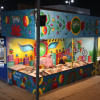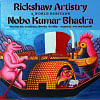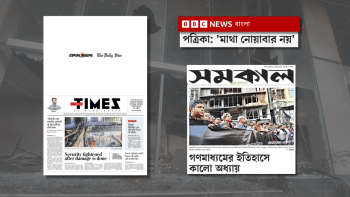Story of a Rickshaw Artist: Md Monir Hossain's struggle and triumph

In the bustling streets of Old Dhaka, where the symphony of honking horns and the smell of street food intermingle, there exists an artist named Md Monir Hossain, whose canvases are not confined to galleries but adorn the humble rickshaws that weave through the city's chaotic lanes. A passionate rickshaw painter, Monir's heart was captured at an early age by rickshaw artistry, leading him down a path that defied societal expectations.
"I grew up in Old Dhaka, and many rickshaw artists, including my teacher Mohammad Hanif Pappu, lived nearby. I fell in love with this art when I was very young, and so, I started rickshaw painting when I was only in second grade. I used to study and practise painting simultaneously," Monir shares, his words resonating with the innocence of a child driven by an unwavering passion.

In 1994, Monir took a significant leap, joining an institution as a painter on Nazimuddin Road. The monthly pay of Tk 100 marked the humble beginnings of a journey that would test his dedication and resilience.
"I left my studies for the love of rickshaw painting. It has been my passion and I turned my passion into my vocation. My teachers, senior artists, and even my friends praised my work, but my family found it difficult to accept that I would leave my studies for rickshaw painting. It was unacceptable to my father," he recounts, a mix of determination and longing evident in his voice.
As Monir's artistic skills bloomed, so did his resolve to uplift the status of rickshaw artistry. The early years were an uphill battle for him; despite the hardships, he found inspiration in the stories woven into the fabric of Dhaka's history. The rickshaw became a moving canvas through which he could tell tales of resilience and hope.
The years from 2000 to 2010 posed the most significant challenges for rickshaw artists like Monir. Many succumbed to economic pressures, leaving the profession for low-paying jobs or returning to their villages. Undeterred, Monir persevered through the digital shift that left traditional artists struggling to survive.
"People started to go digital; we had no jobs and found it difficult to survive. We were miserable and needed to do something to live. In 2010, my teacher Hanif Pappu and I began adorning other products with rickshaw paintings such as sunglasses, hurricane lamps, bottles, jewellery, kettles, etc.," he shares, the struggle evident in his words.
Amidst societal scepticism and financial constraints, Monir clung to his art, finding encouragement from unexpected quarters. "I feel sad and disappointed to see that people don't understand our work or don't want to appreciate it at all. If no one values artists like us, we may disappear like fallen leaves!
"Due to prejudiced beliefs and misconceptions, people have called us crazy for continuing our artistry. However, many foreigners used to walk by our shops. Our art and products fascinated them, and they bought our products. It was a big encouragement for us," he reflects, a flicker of hope in his voice.
Elaborating on his works, Monir informs that his works have been showcased at TSC, Dhaka University and Bangla Academy, which have been praised a lot. But few people know that he was also involved with the graffiti artworks on the pillars of the Moghbazar flyover, which gained immense attraction and appreciation.
Nevertheless, the turning point came when the media began to notice their work, amplifying their voice and reaching a wider audience. Yet, it was Dr Aminur Rahman Sultan, Director of Folklore, Museum, and Archive Division, Bangla Academy, who became a pivotal figure in their journey, assisting in achieving the recognition of rickshaw and rickshaw paintings as an intangible cultural heritage by UNESCO.
Monir highlights, "Many researchers made many promises, but none of them helped us like Dr Sultan, who worked tirelessly to help us gain recognition from UNESCO."
With dreams of imparting the art of rickshaw painting to future generations, Monir envisions establishing a formal institution. Yet, he acknowledges the need for support. "We plan to establish a school or institution so that we can convey the knowledge of rickshaw painting formally. However, we cannot do this alone. We need financial investment and support from the government."
Monir's journey speaks not just of an individual's artistic prowess but of an entire community's resilience against adversity. As he fights to keep rickshaw painting alive, Monir remains hopeful about the days to come, driven by a determination to ensure that the vibrant strokes of this living heritage continue to paint the streets of Dhaka for generations to come.
If you wish to see the works of Monir, please visit the official Facebook page: https://www.facebook.com/bdrickshawartgallery?mibextid=hIlR13 or contact him at +8801720994526.

 For all latest news, follow The Daily Star's Google News channel.
For all latest news, follow The Daily Star's Google News channel. 








Comments